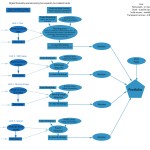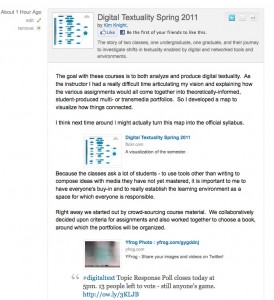The Story of the Story of Digital Textuality, Spring 2011
This semester, I am teaching two very similar classes, one undergraduate (EMAC 4325: Digital Writing) and one graduate (EMAC 6374: Digital Textuality). Though they have different titles, both courses are concerned with acts of communication within digital, networked spaces. In fact, I think the title of 4325 is quite misleading given that “digital composition” within “digital networked spaces” is inevitably done in multiple media formats. So I decided to approach both classes as focusing on developing literacy in “digital textuality,” which naturally includes the relationship between analog and digital forms.
The nature of the courses as well as the fact that there are corresponding instances at the undergraduate and graduate level are allowing me to try a few new things:
1. Crowdsourcing. I have been fortunate in my teaching experience thus far to always have classes small enough that they could be conducted as discussions. I will occasionally use a short lecture format to give background on a topic or object of study, but for the most part I focus on moving me away from the center of the classroom and getting students to share ideas. After reading Cathy Davidson’s blog post over at HASTAC, entitled “How to Crowdsource Grading,” I was enthusiastic about trying it out and only sorry that I hadn’t thought of it first. Crowdsourcing is perfect for my Digital Textuality courses. The subject matter and emphasis on learning to produce ideas in multiple media formats mean that the courses have an underlying foundation of experimentation and play. This is not business as usual in the college classroom. But at the same time that they are being playful, there is a need for students to feel invested in the material and take responsibility for some of their own learning processes. Add to this that we are going to be sharing a lot of resources and peer-reviewing work and it becomes imperative that students feel comfortable in the classroom and trust each other as well as me. Crowdsourcing seemed like a great way to quickly decenter the classroom and to help students develop a sense of ownership. So far we’ve crowdsourced parameters and evaluation criteria for assignments, as well as one of the books we will be reading.
2. One Wiki to Rule Them All. The other opportunity presented by this semester is that the parallel undergraduate and graduate classes allow for unique points of contact between the two student populations. It is my hope that both groups of students will learn more by contact with one another and as such, I decided to use one wiki and one Twitter hashtag for both groups. Their syllabi and reading topics are closely aligned so though they may not be reading exactly the same texts, many of their ideas should have crossover.
Via Twitter they are posing and responding to discussion questions about the weekly reading assignments. This week is week 2 for the undergrads and week 3 for the grads and already I have seen them responding to each other. Though it is tempting to jump in to the discussion, I try to stay out of it. This is about them and their ideas. In the wiki, we are all collecting and curating a list of tools to be used to produce the media objects for their portfolios. At the end of the semester, we will all meet together so that the students can show off their portfolios to one another.
It has been a lot of work and taken more management than usual to get these classes going, but I think that things are going to settle into a rhythm soon. Some time last week, Sara Keeth directed my attention to Storify – a new tool for publishing stories by collecting pieces from various social media streams. I requested access to the beta because I thought it might make a good tool for students to use in the class. After a few days I received an invite code and was anxious to try it out, so I decided to use Storify to tell the story of Digital Textuality, Spring 2011. I think it will be useful to have a persistent record of how these experiments play out. My only real concern is that it is firmly anchored in my perspective. I wish that the platform allowed me to open up the story to other contributors. It would be great if this too could be a collaboration of all of the participants.
The people at Storify indicate that this is a feature that will be developed in the future. So I will stick with the platform and continue to update the Story of Digital Textuality as the semester progresses. Be sure to check in and see what we are up to!
- MLA 2011 Paper for “The Institution(alization) of Digital Humanities”
- MLA 2011 Paper for “What the Digital Does to Reading”
One thought on “The Story of the Story of Digital Textuality, Spring 2011”
Leave a Reply
You must be logged in to post a comment.



Pingback: Tweets that mention kimknight.com » Blog Archive » The Story of the Story of Digital Textuality, Spring 2011 -- Topsy.com